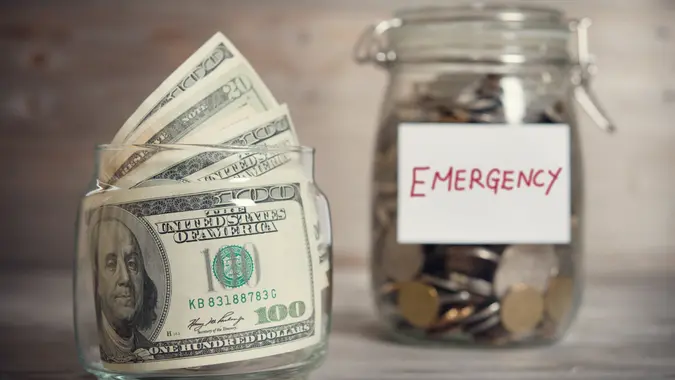George Kamel Offers 11 Daily Habits To Boost Savings Fast

Commitment to Our Readers
GOBankingRates' editorial team is committed to bringing you unbiased reviews and information. We use data-driven methodologies to evaluate financial products and services - our reviews and ratings are not influenced by advertisers. You can read more about our editorial guidelines and our products and services review methodology.

20 Years
Helping You Live Richer

Reviewed
by Experts

Trusted by
Millions of Readers
When trying to save money, you might dread figuring out new ways to lower your expenses, or hit limits when it comes to essentials like housing and groceries. However, you may be overlooking simple ways to spend less by changing how you shop, pay for things or use certain available resources.
In a recent YouTube video, financial expert George Kamel reacted to a BuzzFeed compilation of many small ways people have reported saving money. Consider adopting these 11 small habits that Kamel found useful for the average person into your financial routine.
1. Having a Grocery List
Not only does having a grocery list help reduce return trips, but it can help you save money and reduce impulse spending. Surprisingly, Kamel noted it’s what 85% of millionaires do, based on the Ramsey Solutions National Study of Millionaires. You can use a grocery list app, your phone’s notes or a handwritten list.
2. Waiting Before Making Online Purchases
Since it’s so easy to buy unnecessary things online, giving yourself 24 to 48 hours before checking out might help you avoid some regret and lost money. Kamel explained that this relates to delayed gratification, which will help you build control. You can also consider a longer waiting period, such as 30 days, for larger purchases made offline and online.
3. Not Saving Credit Card Information
Having your payment details saved on websites and apps is convenient, but it can lead to less thoughtful purchases and more wasted money.
Kamel explained, “Removing your card info, using a debit card so that it’s your own money, adding some pain to the purchase — all of that friction helps you make better spending decisions.”
Plus, you’ll avoid the security risks that PayPal noted, such as having your saved payment details potentially stolen through data breaches and hacks.
4. Using the Envelope Budget System
The simple envelope budget system, which involves setting physical cash aside in envelopes labeled for different purchase categories, has become a popular trend on social media.
Kamel liked this one since it limits you to spending only the cash in each envelope, which should help you save money. While it’s trickier for online purchases, you could compromise with a prepaid card or gift card.
5. Making Home Cooked Meals
The latest Consumer Price Index data showed the cost of food away from home, such as restaurant meals, has risen more than the cost of groceries. So, if you tend to dine out, consider planning and cooking homemade meals to save money and reduce food waste.
While he acknowledged it can be challenging, Kamel said you might lower your costs by thousands per year. He added that he used ChatGPT to get meal ideas based on available ingredients, equipment and cooking time.
6. Having Ready-Made Food Available
Sometimes, you might not feel like cooking or find yourself hungry while on the go. Whether you keep snacks in your bag or a few frozen dinners at home, having something readily available can help you resist the urge to pick up expensive convenience food or order delivery.
7. Using Your Local Library
Even if you don’t check out books, a library card can give you free access to streaming services, digital newspaper subscriptions, online courses and more. Some library systems, such as the Cincinnati Public Library, even provide members with passes to local attractions, access to makerspaces, laptop reservations and mobile hotspots.
8. Cutting the Cable
Kamel discussed a user who cut out their cable and Wi-Fi services and relied on an upgraded cellular plan with Netflix access to save $2,160 annually.
Even if you only swap out your cable service for cheap or free streaming plans, you could save hundreds per year. An alternative is revisiting your cable and Wi-Fi packages to see if your provider will let you downgrade or offer a better deal on your current plan.
9. Using Virtual Credit Cards
Another user had luck saving money with Privacy.com, a virtual card service that lets you set limits and avoid giving merchants your real card details.
Kamel explained, “I use it for a lot of free trials where I don’t want it to charge me, or if there’s a site that I don’t want to have my debit card information, I’ll create a virtual debit card and use that on the site instead.”
10. Strategically Spending Gift Cards
A TSG and Bank of America survey found 73% of American consumers were gift card recipients in 2024. While splurging on a “want” can be tempting, using that free money on necessities is a wiser way to save money. For example, you might use a Walmart or Target gift card to cover items on your grocery list.
11. Using Grocery Pickup
Choosing the pickup option at your local grocery store can do more than save you the hassle of shopping and checking out your groceries. As long as you watch out for potential markups and fees, it might be the better financial decision.
Kamel explained, “If I avoid going to the store, I generally save money because I’m not tempted by all the things that could be in said store.”
 Written by
Written by  Edited by
Edited by 

























